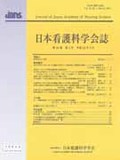Japanese
English
- 販売していません
- Abstract 文献概要
- 参考文献 Reference
- サイト内被引用 Cited by
要旨
本研究は,先天性心疾患をもつ子どものターミナルケアにおける看護師の体験の本質とは何かを明らかにすることを目的とした.小児専門医療施設のICUに勤務する看護師“A”に面接し,語られた内容をGiorgiによる現象学的方法を参考に分析した.その結果,不変的意味の集合体として「子どもがいつ急変するか分からない状況に巻き込まれる」「子どもの生命に直結する家族の意思決定を見守る」「子どもに積極的治療を続ける中でターミナルケアを行う」「救命現場において子どものターミナルケアのための環境を整える」「生まれながら生命危機をもつ子どもと家族の関係を支える」「遺族を気遣いながら亡くなった子どものことを語り合う」の6つの意味群が形成された.さらにすべての不変的意味から,『Aは生命に直結する心臓に障害をもって生まれた子どもの不確かなターミナル期において,子どもの身体状態の急変を予測する中で絶えず葛藤を抱えながらも家族の思いに常に寄り添い,家族が子どもとの絆を強められるように限られた条件の中で最善の環境を保障しようとしていた』というAの個別的な体験の本質が導かれた.
Abstract
The purpose of the present study was to articulate what was the essence of the nurse's experience in end-of-life care who cared for the child with congenital heart disease and the family. The nurse “A” who worked in the ICU of the children's hospital was interviewed, and its biographical narrative was analyzed using the phenomenological method developed by Giorgi.
As a result, six clusters of the most invariant meanings were identified: 1)getting involved in the situation that nobody knows when the child's condition will take a sudden turn for the worse; 2)waiting and seeing the process of decision making by the family directly connected with the child's life; 3)practicing end-of-life care while providing active medical treatment to the child; 4)improving environment to practice end-of-life care in the field of saving life; 5)sustaining the relationship between the family and the child who has been in a life crisis ever since he was born; and 6)talking about the deceased child with the bereaved family, concerning over their feelings.
Furthermore, the essence of the peculiar experience based on all those meanings was emerged: The nurse “A”, in an uncertain period of end-of-life care for the child with congenital heart disorder directly connected with his life, was always close to family's feelings though continually being in dilemmas, and managed to create a best environment for them on the limited condition so that they can strengthen the bonds each other.
Copyright © 2013, Japan Academy of Nursing Science. All rights reserved.


